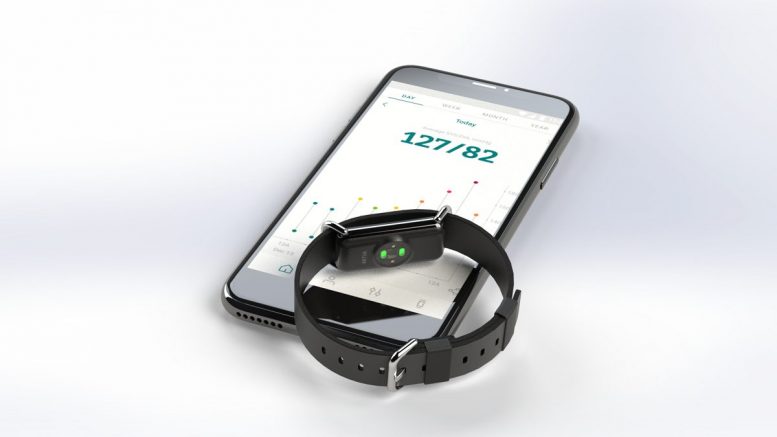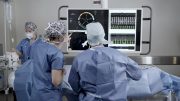Aktiia recently announced the first 24-7, automated blood pressure monitoring system that easily and comfortably gathers data during the day and while sleeping. This ground-breaking medical innovation will now provide people and their physicians comprehensive insights into blood pressure patterns that will better inform the diagnosis and management of hypertension.
Millions of people worldwide are at risk for severe health complications and death due to untreated or uncontrolled hypertension. The average person with hypertension measures their blood pressure only once per week due to the inconvenience and discomfort associated with a traditional cuff.
Aktiia is the first product to automatically measure blood pressure over the course of hours, days and weeks without any effort required by the wearer. The data is then visualised in a free companion application and can also be shared with a physician or family member to detect concerning blood pressure changes.
The core technology was first developed at the prestigious Swiss Center for Electronics and Microtechnology (CSEM). Aktiia was then founded in 2018 by Dr. Mattia Bertschi and Dr. Josep Sola and includes some of the world’s leading scientific and technical experts in optical blood pressure monitoring including CTO, Dr. Josep Sola, a pioneer in cuffless blood pressure monitoring and editor of “The Handbook of Cuffless Blood Pressure Monitoring” – Aktiia has been validated in multiple clinical studies across a diverse population of wearers in multiple body positions.
We spoke to Dr Gregoire Wuerzner who ran the clinical trials to find out more about the Aktiia solution:
How does this solution differ from conventional wearable blood pressure monitoring devices?
Aktiia’s Optical Blood Pressure Monitoring (OBPM) algorithms leverage optical sensors worn on the wrist and provide blood pressure values using photoplethysmography (PPG) to analyze the changing diameter of the arteries occurring at each heartbeat. This optical measurement is repeated automatically, so users are not aware of the measurements, thus removing the possible stressing effect of measurement itself. The wearer does not have to interrupt their day and sleep time to take a measurement. This is different from the oscillometric method of measuring blood pressure that involves inflating a cuff on the upper arm that analyses pulse waves during constricted blood flow.
For devices that have been validated, both approaches have comparable accuracy (as defined by ISO standards). The major difference to the patient and the physician between the two methods is that with automated, persistent blood pressure monitoring hundreds of readings can be taken per week to achieve a much deeper understanding of a patient’s blood pressure pattern versus a conventional blood pressure monitoring device that may for some patients only be used 1-2x per week if ever.
Which patient groups do you expect to benefit most from the device?
The product was specifically designed for people that have been diagnosed with hypertension. Aktiia provides them a simpler, more elegant way to consistently monitor their blood pressure and share that data with their physician.
Within this patient group, some sub-groups or phenotypes will realize even greater benefits. These phenotypes could include people with white coat hypertension, masked hypertension for whom office blood pressure does not reflect the true cardiovascular risk and abnormal circadian patterns (aka people who don’t experience a dip in their blood pressure at night).
One of the biggest stumbling blocks for wearable devices is ‘user fatigue’ and patients failing to wear a device. How do you plan to overcome that problem?
The biggest issue with most wearable products is that they don’t solve a real problem. As a result, the wearer may lose interest and eventually stops wearing the device. Our target user has a serious medical condition with real consequences if not properly managed. They are already monitoring via a conventional blood pressure monitoring device. Aktiia has simply made that experience more convenient, more insightful, and less stressful. This is essential if the objective is patient empowerment, which has been lacking so far in the management of hypertensive patients.
As a clinically validated, medical device with the necessary regulatory approvals we are also able to present real medical information to the user instead of the wellness data provided by most consumer wearables. For example, one of the key features that has garnered a lot of positive user feedback is our ability to tell a person the percentage of time per day that they are within their target blood pressure range. This represents actionable health data that can be used by the patient and their physician to adjust treatment.
What sort of insights can a patient get from constant blood pressure monitoring and how is that data used to provide the wearer with actionable options to manage their condition?
24/7 blood pressure monitoring provides patients and physicians actionable data to better control high blood pressure. Specifically, it can provide specific answers to the following questions:
- How does my lifestyle impact my blood pressure control? 24/7 blood pressure monitoring provides higher resolution data, over time and can be mined to better understand the impact of diet, exercise, stress management, and sleep patterns on a person’s blood pressure.
- What percentage of the day, week, month am I in my target blood pressure range? With persistent blood pressure monitoring, you can easily determine what percentage of the time that a person is in their target range over a day, week, or month. This data provides a more accurate view of how well a person’s high blood pressure is being managed.
- Am I seeing a drop in my blood pressure while I sleep? Almost 35% of people diagnosed with hypertension have abnormal circadian BP variance. This is also known as non-dipping where a person’s nighttime average blood pressure does not decrease in a meaningful way relative to their daytime blood pressure average. Research studies have shown that non-dippers are at increased risk for heart attack and stroke. In the past, nighttime BP readings were only available with an ambulatory blood pressure monitor that would be prescribed for a single night of use. Knowing that a person’s BP doesn’t dip at night may lead a physician to prescribe a different treatment regimen tailored to that patients’ unique needs.
- How effective is my anti-hypertensive medication? Anti-hypertensive medication titration is often a trial-and-error process that can delay the time to control or worse contribute to lower adherence rates and clinical inertia where the medication strategy is not being changed to meet the needs of the patient.
By monitoring hypertension in this way, what are some of the specific clinical benefits that patients and providers will derive?
- More Accurate Diagnosis – Approximately 30% of people with hypertension experience a phenomenon called “white coat” or “masked” hypertension. White coat hypertension occurs when a person presents higher blood pressure in the clinic than they do in normal life. Masked hypertension occurs when the patient presents lower blood pressure in the clinic than they do in real life. Both lead to inaccurate diagnoses at the physician’s office that could lead to over-treating or undertreating a significant number of patients. Real-life blood pressure monitoring has the potential to avoid therapeutic mismanagement.
- More Personalised Treatment. A specific area that 24/7 blood pressure data can address because it gathers both day and night data is the large number of people that have abnormal circadian BP variance. This is also known as non-dipping where a person’s night-time average blood pressure does not decrease in a meaningful way relative to their daytime blood pressure average. As mentioned before, about 35% of hypertensive patients exhibit this non-dipping behaviour. Research studies have shown that non-dippers are at increased risk for heart attack and stroke. Knowing that a person’s BP doesn’t dip at night may lead a physician to prescribe a different treatment regimen tailored to that patients’ unique needs.
- More Engaged Patients. Feedback loops are a powerful way to motivate patient engagement and behaviour change. Traditional blood pressure monitoring technologies often collect too few data points to be able to effectively provide feedback to the patient regarding the impact that their diet, exercise, medication, stress management, or sleep health has on their hypertension. The promise of 24/7 blood pressure monitoring is that it provides more data, over time and can be mined to better understand cause and effect relationships that can be used to motivate more consistent patient engagement
- Less stress for the patient. Once the device is calibrated, the patient doesn’t have to worry about blood pressure measure and readings, the device does it automatically without any annoyance, thus decreasing the stress around the measurement.
We also asked Aktiia’s CEO Michael Kisch; Are you planning to target the consumer market with this product or are you looking for a prescriber route to market?
Aktiia has two customers and therefore two routes to market. The first is the user who struggles with high blood pressure and desires to better understand their daily blood pressure pattern and understand the impact that lifestyle changes and medication have on their hypertension management. For this customer, we can sell through consumer channels similar to how most home blood pressure monitors are sold today. This approach targets the consumer who is more engaged in their healthcare and comfortable evaluating and purchasing at home monitoring technologies.
The second customer is the healthcare provider engaged in the diagnosis and management of populations of hypertensive patients. Their motivation is to be able to better monitor their patients and provide more tailored and timely care. In this scenario, we are selling a complete blood pressure monitoring solution that integrates with the provider’s clinical workflow and existing hypertension management program. This approach is targeted towards the patient that relies heavily on the advice and guidance of their physician.





